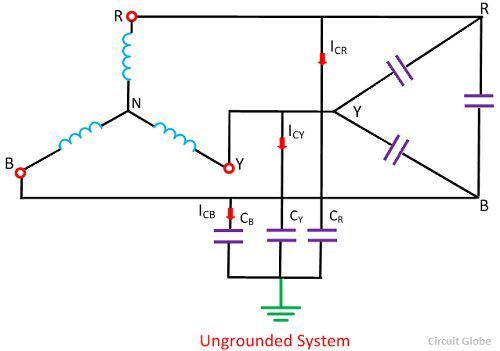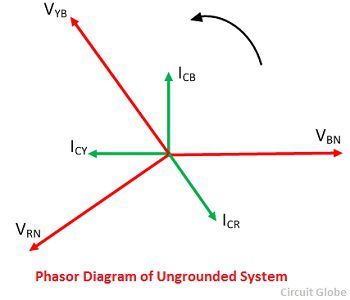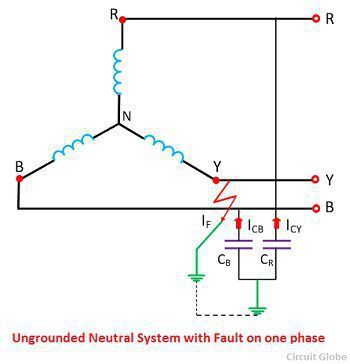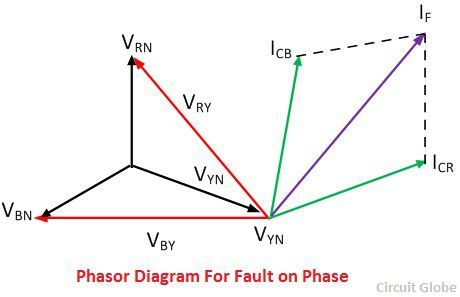Definition: The system without neutral grounding is known as the ungrounded system, or in other words, in the ungrounded system, none of their conductors is connected to the ground. The main feature of the ungrounded system is its ability to remove the earth faults without interruption. But the self-cleaning process of the ungrounded system become disappear when the length of the conductor becomes excessive.
The ungrounded three-phase system is shown in the figure below. The line conductors of the system have capacitance between one another and the earth. The former being delta connected and the next become star connected as shown in the figure below. The effect of the line capacitance on the ground is less as compared to the conductors. Therefore, they can neglects.

If the line has same capacitance to ground, then the charging current for each line to earth capacitor lead the phase voltage by 90º and are equal. The magnitude of the current is given by the ratio of the phase voltage VP and the reactance due to capacitance XC.
The charging current ICR, ICY and ICB are balanced, and their resultant is zero and no current flows to the earth. When the system is in the balanced condition, then the potential of their neutral is held at the ground due to the presence of the shunt capacitance of the system. The phasor diagram of the balanced condition of the system is shown in the figure below.

Ungrounded System with Fault on One Phase
Consider a phase to earth fault in line Y. In this condition, the faulty line takes the earth potential, and the potential of the remaining two lines arise from the phase potential to the line value. The capacitance currents become unbalanced and the fault current flow through the faulty line into the earth and return through the capacitance CR and CB.
 The fault current IF has two components ICR and ICB, which flow through capacitance CR and CB under the potential difference of VRY and VBY respectively.The current ICR and ICB leads from their respective voltage by 90º, and their phasor sum is equal to fault current IF.
The fault current IF has two components ICR and ICB, which flow through capacitance CR and CB under the potential difference of VRY and VBY respectively.The current ICR and ICB leads from their respective voltage by 90º, and their phasor sum is equal to fault current IF.
![]() The phase voltage of the line is equal to Vp, and the capacitance of the line is also equal to the XC. The fault current is equal to the phasor sum of ICR and ICB as shown in the below
The phase voltage of the line is equal to Vp, and the capacitance of the line is also equal to the XC. The fault current is equal to the phasor sum of ICR and ICB as shown in the below

From the figures shown above the following points are concluded.
- There is no zero sequence current, and because of this, there will be little interferences with the communication lines.
- In the case of the fault in one phase the remaining two healthy phases of the line become raises from their phase value to the full line value. This cause the stress on the equipment of the three-phase ungrounded systems.
- The capacitance currents in the two healthy phases increase from √3 times to their normal values.
- In the ungrounded system, the voltage due to lightning surges does not find the path to the earth, thus raise the voltage of the system.
For the above mention reason, the ungrounded or isolated system is undesirable for the high voltage three phase system.


